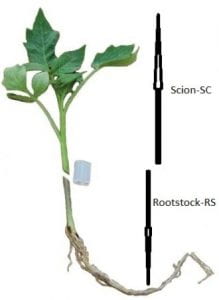Rose Ogutu, Horticulture Specialist, Delaware State University rogutu@desu.edu
Why graft tomatoes, given the increased labor and seed costs?
Think of great losses that can be brought about by diseases, pests, and high salt susceptibility that can wipe off a whole crop. Disease resistance, better tastes and increased productivity are benefits of grafting that will outweigh the costs.
Figure 1. A grafted tomato plant is made from at least two different varieties consisting of: a Scion (SC) and a Rootstock (RS)
What makes the best rootstock?
Vigor and disease resistance are a major selection criteria in the development of new rootstock varieties. The diversity of rootstock varieties is increasing steadily but is not yet diverse as the options for scions. By September 2013, there were up to 65 or slightly more commercially available rootstocks documented from seed catalogs and websites (Bumgarner and Kleinhenz, 2013). The rootstock confers certain characteristics to the eventual plant. The rootstock should be even in diameter with the scion (especially when using tube of splice grafting) and should have excellent field performance (vigor, yields etc). Seeding rootstocks and scion varieties multiple times (staggered seeding) increases the chances of having similar sizes of both plants at any given grafting session. Keeping records of growth rate differences between the RS and SC help determine the best day to sow them in order to have uniform plants. Cleft grafting method allows for variance in stem sizes in the RS and SC. When grafting, sanitation should be observed to avoid graft transmissible diseases from viruses and bacteria.
Grafting Tomatoes is Gaining Popularity
Consumers have favorite heirloom tomato varieties that have been passed down through generations of farmers and gardeners and are irresistible due to flavor, color or yield, yet are prone to certain tomato diseases, pests and environmental stresses. Hybrid tomatoes are often bred to resist diseases and cracking. Theoretically, grafting an heirloom which is susceptible to a certain soil borne disease to a standard (less expensive) hybrid (as RS) which is resistant to it should be advantageous if the disease is likely to occur.
Your popular tomato variety might be missing some of the disease resistance codes in Table 1 on the seed packet, denoting susceptibility
Table 1: Tomato Disease Resistance Codes
|
V |
Verticillium Wilt |
|
F |
Fusarium Wilt (FF – Races 1 & 2; FFF-Races 1,2 & 3) |
|
N |
Nematodes |
|
T |
Tobacco Mosaic Virus |
|
A |
Alternaria Stem Canker |
|
St |
Stemphylium Gray Leaf Spot |
|
TSWV |
Tomato Spotted Wilt Virus |
Tomato is still the number one high-tunnel crop. High tunnel growers start realizing salt build up as soon as the 4th year of production. If care is not taken the salts might be too high and can affect tomato plants. In such cases, grafting onto a scion that has resistance to high salts can serve as a remedy.
Plant lovers enthused with grafting are using it to come up with one or two plants that will provide more varieties to meet their needs.
The list of grower-oriented resources on vegetable grafting is increasing and opportunities for farmers to help produce educational resources are also expanding. You can download version 2 of -The OSU/OARDC-OSUE Tomato Grafting Guide at no charge at: http://hcs.osu.edu/vpslab/grafting-guide.
Do Delaware farmers need to consider grafting tomatoes?
Some of the popular tomato varieties used by Delaware growers are indicated in the table below. As you prepare to grow for the season, consider having a few of the plants grafted on resistant rootstocks. Always choose the best variety for your purposes and location and when buying tomato plants choose strong sturdy plants and avoid leggy seedlings.
Some Popular Tomato Varieties and Their Characteristics
| Tomato Variety | Seed Type | Resistance |
| Celebrity | Hybrid | VFFNTA |
| Brandywine | Heirloom | TMVNVFF, corky root rot, fusarium crown and root rot |
| Big Boy | Hybrid | A, stem canker and crack resistance |
| Beef Master | Hybrid | VFFNASt, |
| Roma | Heirloom | VFN |
| Big Beef | Hybrid | AFFNT |
References
Bumgarner N. R. and M. D. Kleinhenz. 2013. Grafting Guide- A pictorial Guide to the Cleft and Splice Graft Methods as Applied to Tomato and Pepper. Ohio State University Extension.

